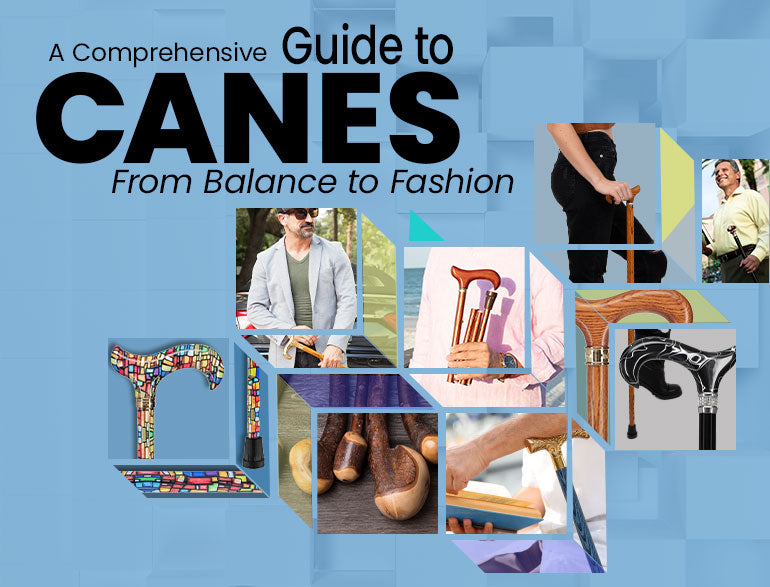The Comprehensive Guide to Canes: From Balance to Fashion
Posted by SAMUEL NORIEGA

Whether you're browsing canes for the first time or thinking about upgrading to something more stylish or functional, you're in the right place. This guide is built to answer the questions most people never get clear answers to: What type of cane should I use? How do I know it fits right? What’s the difference between a quad cane and a folding one?
We’re not here to overwhelm you with jargon or medical talk. Instead, we’ll walk you through everything—practically, clearly, and with a touch of style.
So, let’s begin.
Understanding the Different Types of Canes
There’s no such thing as a one-size-fits-all cane. What works for one person might not work for another. Some prefer the sleek lines of a lucite cane for daily errands, while others need a quad cane for maximum balance and support.
Here’s a breakdown of the most common types you’ll find:
Standard Canes
The classic single-point cane. These are great for light support and daily use. Many of our men’s and women’s canes fall under this category.
Quad Canes
Designed with a four-pronged base, quad canes offer more stability than single-point styles. Ideal for users with balance concerns or those recovering from injury.
According to Harvard Health, quad canes provide extra support for those who have experienced a stroke or suffer from muscular weakness.
Folding Canes
Perfect for on-the-go use. These canes collapse down into compact sections and fit easily into a purse, backpack, or travel bag.
Seat Canes
A cane and a portable seat in one. These are especially helpful for outdoor events, museums, or long lines when you may need to pause and rest.
Fashion Canes
Function meets flair. Our decorative and engraved canes come in countless styles—florals, jewel-accented, carved woods, and more.
How to Choose the Right Cane for Your Needs
There are a few key things to keep in mind when selecting your cane:
1. Support Level
Ask yourself: do you need mild balance assistance, or something that offers more stability? If you’re post-surgery or have been advised by a doctor, a quad cane might be the way to go. For casual or fashion-forward support, a single-point cane is often ideal.
2. Proper Fit
A poorly sized cane can lead to discomfort, shoulder strain, or even falls. The general rule: when standing upright, your cane should reach the crease of your wrist. (Cleveland Clinic)
3. Handle Style
This matters more than most people realize:
Derby Handles – Easy to grip and ergonomic
Fritz Handles – Ideal for arthritic hands
Offset Handles – Designed for weight distribution and comfort
Check out our full guide on how to choose the right cane for more tips and our ultimate buyers guide.
The Best Cane for Balance
If balance is your primary concern, a quad cane might be the best choice. With its four-point base, it provides more stability than a single-point cane. It can stand on its own, offering constant support and making it easier to navigate uneven surfaces.
Cane Materials: What Should Yours Be Made Of?
Materials aren’t just about looks—they affect weight, feel, and durability.
Wood – Timeless, classic, often used for formal or carved canes
Aluminum – Lightweight and often adjustable; great for travel
Carbon Fiber – Strong, light, and built for long-term use
Lucite – A modern, transparent material that turns heads and keeps things light. Many Lucite canes also feature light-up options, providing extra visibility and safety when walking in dark areas or at night.
How to Use a Cane Properly
Even a high-quality cane won’t help if it’s not used correctly. A few simple rules:
- Hold the cane in the hand opposite the weaker or injured leg.
- Move the cane forward at the same time as that leg.
- Keep the cane tip about 2 inches in front of your foot for stability.
- Replace the cane tip regularly for grip and safety.
Bonus: According to NIH studies, improper cane use increases fall risk. It’s worth getting this right.
Style Tips: Yes, You Can Accessorize
A cane can be just as expressive as a handbag or scarf. Don’t be afraid to treat it like part of your outfit.
- Try a rhinestone-accented cane with your favorite evening wear.
- Match a wood-grain cane to your leather shoes or belt.
- Use a clear lucite cane for a futuristic, minimal look.
- Pick a floral folding cane for a touch of fun while traveling.
For added style and convenience, consider pairing your cane with one of our wrist straps. Choose from sleek faux leather straps or elevate your look with our FashionStix Luxury Wrist Strap, perfect for keeping your cane close and secure while adding a touch of sophistication.
If you’re dressing up for an event, a decorative cane—and the right wrist strap—can actually elevate your look, not just complement it.

